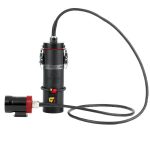 Awesome diving doesn't only happen in the bright, crystal clear blue waters of the ocean. When you're diving adventure takes you into darker waters such as night diving, wreck diving, deep diving, or cavern/cave diving, the last thing you want to forget is a bright dive light so you can actually see the wonders that are around you. With literally hundreds of different kinds of dive lights to choose from, it can be a bit overwhelming to pick the right type of light for the kind diving you're going to be doing. This dive light guide will hopefully give you some direction in choosing the perfect light for your next diving adventure.
Awesome diving doesn't only happen in the bright, crystal clear blue waters of the ocean. When you're diving adventure takes you into darker waters such as night diving, wreck diving, deep diving, or cavern/cave diving, the last thing you want to forget is a bright dive light so you can actually see the wonders that are around you. With literally hundreds of different kinds of dive lights to choose from, it can be a bit overwhelming to pick the right type of light for the kind diving you're going to be doing. This dive light guide will hopefully give you some direction in choosing the perfect light for your next diving adventure.
5 Types of dive lights and when to use them:
 Primary Dive Light
Primary Dive Light
Primary dive lights are the larger handheld style of lights you commonly see divers using on night dives and dives in murkier waters. Your primary light will provide enough illumination so that you will be able to dive with no other light source. This is your main dive light on darker dives, like night dives.
 Secondary Dive Light
Secondary Dive Light
Your secondary light is also known as your backup light. This is typically a small handheld light and can be used during both daytime dives, to provide a little extra illumination along the reef, and night or penetration dives, to act as a backup to your primary light, in the event that it runs out of batteries or malfunctions. These lights are normally small enough to fit into your BC pocket.
Wrist and Head Mount Lights

For the diver that needs both hands free, the best option is what is called a 'wrist mount' dive light. Divers such as wreck, cavern, and cave divers who may need to operate a reel or other equipment and, therefore, use both hands during the dive, would ideally prefer a wrist mount dive light that attaches to their wrist or top of the hand. Along with a wrist mount dive light, these divers may also use a head mount dive light, similar to those commonly seen on hikers and campers. This is another way to add light to the dive while still keeping both hands free.
Canister Lights
 Canister lights, otherwise known as Can lights, are more prevalent among technical divers and those doing penetration dives, such as wreck and cave diving. These lights are named as such because the battery pack is held in a separate 'canister' than the actual lightbulb. The light is supplied via a light bulb that is connected to the caster with a long, thick wire. You can connect the lighting bulb to either your waist or wrist. Can lights are rechargeable, having a larger battery than your typical primary light, and therefore giving a brighter and sometimes wider beam of light than your typical hand-held primary light.
Canister lights, otherwise known as Can lights, are more prevalent among technical divers and those doing penetration dives, such as wreck and cave diving. These lights are named as such because the battery pack is held in a separate 'canister' than the actual lightbulb. The light is supplied via a light bulb that is connected to the caster with a long, thick wire. You can connect the lighting bulb to either your waist or wrist. Can lights are rechargeable, having a larger battery than your typical primary light, and therefore giving a brighter and sometimes wider beam of light than your typical hand-held primary light.
Video Lights
 You'll see video lights being used by videographers. These differ from strobe lights used during underwater photography in that a constant beam of light is emitted, instead of just a flash of light given off when an image is taken. A good video light will not have a heavy center hot-spot in the beam but a wide, even flood of light. They will also have mounting points on them for attaching to your video housing. These lights can be used in lieu of a traditional dive light if you're planning on video taping while on your dive.
You'll see video lights being used by videographers. These differ from strobe lights used during underwater photography in that a constant beam of light is emitted, instead of just a flash of light given off when an image is taken. A good video light will not have a heavy center hot-spot in the beam but a wide, even flood of light. They will also have mounting points on them for attaching to your video housing. These lights can be used in lieu of a traditional dive light if you're planning on video taping while on your dive.
As you can see, choosing a dive light is no quick thing. There are many different types of dive lights out there so the first step in choosing your light is deciding which kind you need or want first. In part 2 of this blog next week, we will get into more specific details on how to choose a good light within each of the light categories listed here. So be sure to check in with us next week!






